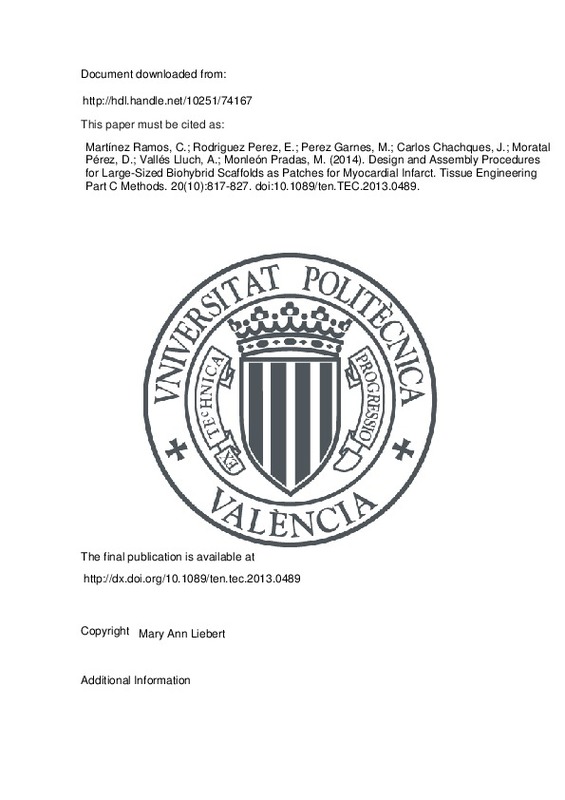JavaScript is disabled for your browser. Some features of this site may not work without it.
Buscar en RiuNet
Listar
Mi cuenta
Estadísticas
Ayuda RiuNet
Admin. UPV
Design and Assembly Procedures for Large-Sized Biohybrid Scaffolds as Patches for Myocardial Infarct
Mostrar el registro sencillo del ítem
Ficheros en el ítem
| dc.contributor.author | Martínez Ramos, Cristina
|
es_ES |
| dc.contributor.author | Rodríguez Pérez, Eduard
|
es_ES |
| dc.contributor.author | Perez Garnes, Manuel
|
es_ES |
| dc.contributor.author | Chachques, Juan Carlos
|
es_ES |
| dc.contributor.author | Moratal Pérez, David
|
es_ES |
| dc.contributor.author | Vallés Lluch, Ana
|
es_ES |
| dc.contributor.author | Monleón Pradas, Manuel
|
es_ES |
| dc.date.accessioned | 2016-11-16T09:23:34Z | |
| dc.date.available | 2016-11-16T09:23:34Z | |
| dc.date.issued | 2014-10-01 | |
| dc.identifier.issn | 1937-3384 | |
| dc.identifier.uri | http://hdl.handle.net/10251/74167 | |
| dc.description.abstract | [EN] Objective: To assemble a biohybrid cardiac patch consisting of a large (5x5 cm) elastomer scaffold whose pores are filled with a self-assembling peptide (SAP) gel entrapping adipose stem cells, to be used as a novel implant in a big animal model (sheep) of myocardial infarction. The study focuses on the way to determine optimal procedures for incorporating the SAP solution and the cells in the patch to ensure cell colonization and a homogeneous cell distribution in the construct before implantation. The problems associated with the scale-up of the different procedures raised by the large size of the construct are discussed. Materials and Methods: Experiments were performed to choose between different assembling alternatives: incorporation of the SAP gel before cell seeding or simultaneous SAP and cell loading of the scaffold; surface seeding of cells or cell injection into the scaffold pores; dissemination of the cells throughout the scaffold before incubation by gentle shaking or by centrifugation. Immunocytochemistry techniques and confocal and scanning electron microscopies were employed to assess and quantify cell colonization of the material and early cell distribution. Cell concentrations and the uniformity of cellular distribution throughout the scaffold were taken as the main criteria to decide between the different alternative procedures. Results: The combination of peptide preloading, cell injection, and shaking before incubation yielded the best results in terms of greater cell density and the most uniform distribution after 24 h of culture compared with the other methods. These techniques could be scaled-up to obtain large biohybrid cardiac patches with success. Conclusions: The results obtained after the different seeding methods allowed us to establish an effective protocol for the assembly of large biohybrid patches for their subsequent implantation in the heart of a big animal model of myocardial infarct in the context of a preclinical study. | es_ES |
| dc.description.sponsorship | The authors acknowledge the financing from the European Commission through the ‘‘Regeneration of cardiac tissue assisted by bioactive implants’’ (RECATABI) FP7 NMP3-SL-2009-229239 project. MMP acknowledges support of Instituto de Salud Carlos III with assistance from the European Regional Development Fund through CIBER-BBN initiative. | |
| dc.language | Inglés | es_ES |
| dc.publisher | Mary Ann Liebert | es_ES |
| dc.relation.ispartof | Tissue Engineering Part C Methods | es_ES |
| dc.rights | Reserva de todos los derechos | es_ES |
| dc.subject.classification | MAQUINAS Y MOTORES TERMICOS | es_ES |
| dc.subject.classification | TECNOLOGIA ELECTRONICA | es_ES |
| dc.title | Design and Assembly Procedures for Large-Sized Biohybrid Scaffolds as Patches for Myocardial Infarct | es_ES |
| dc.type | Artículo | es_ES |
| dc.identifier.doi | 10.1089/ten.TEC.2013.0489 | |
| dc.relation.projectID | info:eu-repo/grantAgreement/EC/FP7/229239/EU/Regeneration of Cardiac Tissue Assisted by Bioactive Implants/ | es_ES |
| dc.rights.accessRights | Abierto | es_ES |
| dc.contributor.affiliation | Universitat Politècnica de València. Escuela Técnica Superior de Ingenieros Industriales - Escola Tècnica Superior d'Enginyers Industrials | es_ES |
| dc.contributor.affiliation | Universitat Politècnica de València. Centro de Biomateriales e Ingeniería Tisular - Centre de Biomaterials i Enginyeria Tissular | es_ES |
| dc.description.bibliographicCitation | Martínez Ramos, C.; Rodríguez Pérez, E.; Perez Garnes, M.; Chachques, JC.; Moratal Pérez, D.; Vallés Lluch, A.; Monleón Pradas, M. (2014). Design and Assembly Procedures for Large-Sized Biohybrid Scaffolds as Patches for Myocardial Infarct. Tissue Engineering Part C Methods. 20(10):817-827. https://doi.org/10.1089/ten.TEC.2013.0489 | es_ES |
| dc.description.accrualMethod | S | es_ES |
| dc.relation.publisherversion | http://dx.doi.org/10.1089/ten.tec.2013.0489 | es_ES |
| dc.description.upvformatpinicio | 817 | es_ES |
| dc.description.upvformatpfin | 827 | es_ES |
| dc.type.version | info:eu-repo/semantics/publishedVersion | es_ES |
| dc.description.volume | 20 | es_ES |
| dc.description.issue | 10 | es_ES |
| dc.relation.senia | 276580 | es_ES |
| dc.contributor.funder | European Commission | |
| dc.contributor.funder | Instituto de Salud Carlos III |







![[Cerrado]](/themes/UPV/images/candado.png)

